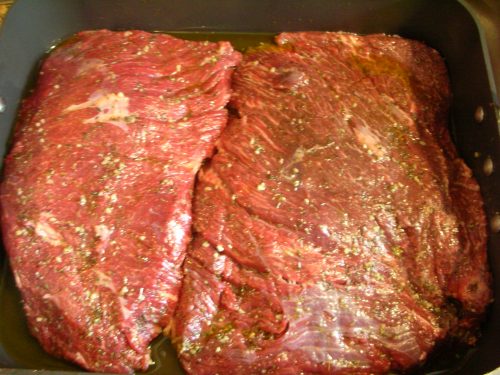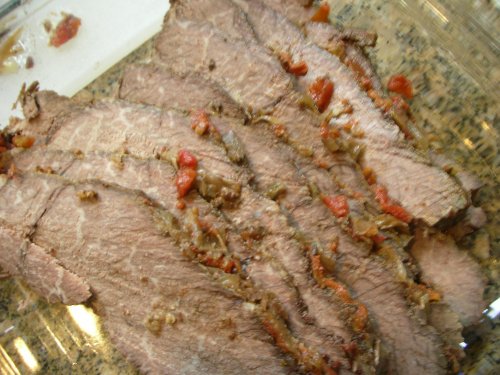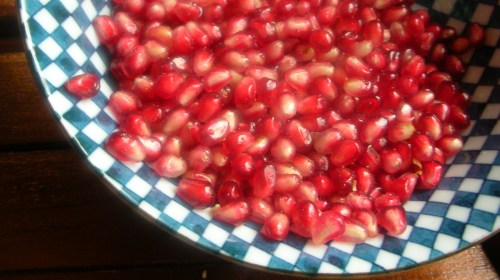
One year in elementary school, we had a “Mitzvah Fair.” Sort of like a Science Fair, but fewer experiments.
We had learned in Hebrew class that there were 613 seeds in a pomegranate, supposedly corresponding to the number of mitzvot — commandments or good deeds (depending on the context) — in the Torah. So, I paired up with a friend and we counted the number of seeds. Well, we tried to. We bought two fruits, trying to make this project as scientific as possible, but weren’t able to count beyond about 400 per pomegranate. And, we did count the ones we ate.
That was the first time that I had ever seen or tasted a pomegranate and to my pre-teen self, the fruit was the epitome of exotic. My friend and I had no idea how to remove the seeds. We cut the fruit in quarters, losing many seeds in the process, and then plucked the remaining seeds out by brute force with our less-than-nimble fingers. Perhaps that’s why we didn’t get close to the expected 613.
Now pomegranates seem fairly common, and the juice is ubiquitous. And, thanks to a tip from my Atlanta family, I now know that the easiest way to remove pomegranate seeds is to carefully slice through the skin, gently pry open the fruit, and submerge it in a bowl of water. The water helps loosen the seeds (called “arils”) and they sink to the bottom while the membrane floats. You can then roll remaining seeds out of the fruit, re-submerging the clustered seeds periodically to help separate them from the membrane.
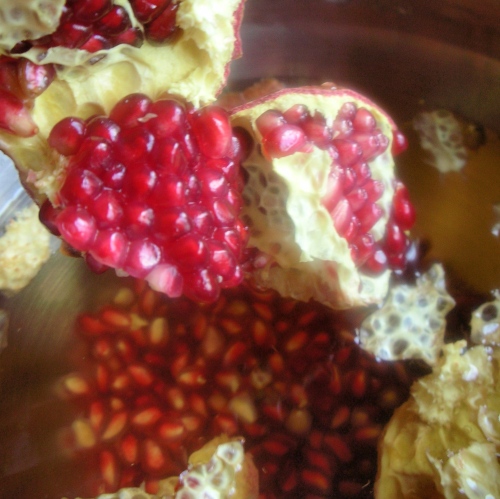
Our pomegranate experiment less than successful, my friend and I parted ways. Instead, I recorded myself as G-d giving the Ten Commandments to Moses.
Talk about hubris!
I found the room in the house with the best acoustics – the bathroom – and sat in the tub with a “boom box” taping my forced deep voice, enumerating each commandment and explaining it to the best of my nine year old abilities. To this day, I remember saying, “Thou shall not covet thy neighbor’s wife” and explaining, “for she is your neighbor’s and not yours.” Yes, I really said “for” in lieu of “because.”
Pomegranate Chicken

Adapted from Ethel Hofman’s Everyday Cooking for the Jewish Home. I doubled the recipe (and have included that doubling here) and used mostly boneless skinless chicken breasts. Essentially, you poach the chicken in olive oil which keeps the meat moist and the chicken can be easily reheated without fear of drying out. The original recipe calls for making juice from pomegranate seeds, but I take a shortcut, using either pomegranate juice of concentrate (which is just a juice reduction available in many Middle Eastern grocery stores). Pomegranates are traditionally eaten on Rosh Hashana as a reminder of the commandments that we have kept over the past year, as we pray in synagogue for our merits to be counted. I have made this dish the past two years as part of my family’s Rosh Hashana meal.
Serves 8-10
– 1/3 – 1/2 C olive oil
– 4 T minced garlic
– 2 (3 1/2 to 4-pound) chickens, quartered or 8 boneless skinless chicken breasts or a mix
– 1/2 C pomegranate juice or 1/4 C pomegranate concentrate
– 1/2 C dry white wine (I used Beckett’s Flat 2004 Reserve Chardonnay)
– Juice of 2 lemons (~ 1/4 C)
– 1 T cinnamon
– 1 T sugar
– Salt and pepper
Preheat oven to 375º F.
Bake chicken. Spread chicken pieces in a pan in a single layer. Cover with minced garlic, salt and pepper, and drizzle with olive oil. The recipe calls for 1/4 C oil per whole chicken, but this seemed like a little too much to me, so I cut the oil down a bit; use your judgment — there should be approximately 1-inch of oil in the tightly-packed pan . You could also toss the chicken, oil, and garlic in a ziplock bag and then spread the chicken in the pan. Bake in oven, uncovered, for 45 minutes. Baste every 10 minutes or so with the pan juices. My chicken did not brown at all.
Prepare sauce. Bring to boil pomegranate juice or concentrate, white wine, lemon juice, cinnamon and sugar. Lower heat for 5 minutes. The sauce should reduce to about 3/4.
Finish chicken. Drain excess oil from chicken. Pierce each chicken piece several times and pour sauce over chicken. Continue baking chicken with sauce for 10-15 minutes.
This chicken is great served at room temperature and on salads. If you have a pomegranate, sprinkle some of seeds on as garnish.

Pomegranate Salad Dressing

Using virtually the same flavor combination as the pomegranate sauce, I created a salad dressing to complement the chicken that I cut up and threw on a bed of baby spinach.
– 1/2 C pomegranate seeds
– 1/4 C olive oil
– 2 T pomegranate concentrate
– Juice of 1 lemon (~2 T)
– 1 t cinnamon (optional)
– 1 t sugar
– salt and pepper to taste
Mix all ingredients together in a bowl and let the flavors mingle for at least 20 minutes.
Toss liberally over salad greens and sliced pomegranate chicken.
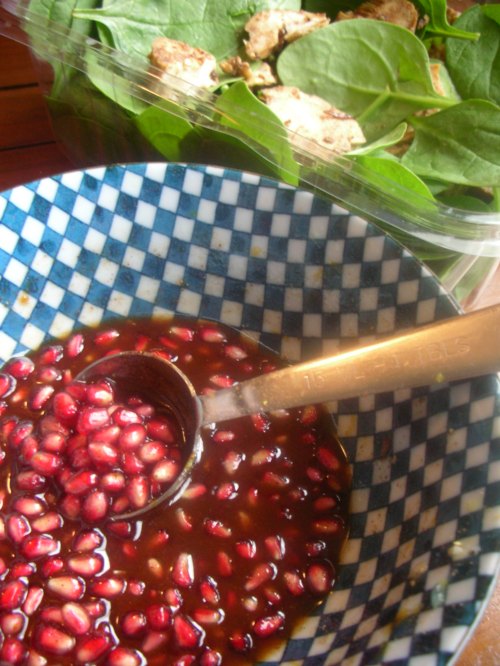

That was the first time that I had ever seen or tasted a pomegranate and the fruit was extraordinarily exotic to me. We had no idea how to remove the seeds and did it by brute force, plucking each seed out with our less-than-nimble fingers, crushing many in the process. Perhaps that’s why we didn’t get close to the expected 613.
Now pomegranates seem fairly common, and the juice is

